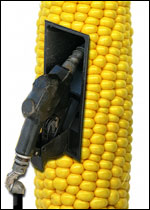Earlier this year, after Archer Daniels Midland reported surging profit for the fourth quarter of 2005 — largely driven by its ethanol unit — I dubbed the company the Exxon of Corn.

As if to prove my thesis, the grain-processing giant tapped an oil exec as its new CEO last week. And, like any respectable would-be oil company, it also reported another quarter of robust profit growth. The ascension to CEO of Patricia Woertz, most recently executive vice president at Chevron, marks the end of a four-decade run at ADM’s top by the Andreas family. That venerable clan, whose chicanery runs from a key role in the Watergate scandal to a price-fixing scheme in the 1990s, built ADM into one of the U.S.’s most politically connected corporations. Congressional beneficiaries of ADM’s campaign generosity likely need not fear; G. Allen Andreas, who has served as CEO since 1997 (when his uncle and predecessor was convicted of fixing the price of lysine, a corn product used in animal feed), will stay on as chairman of the board of directors.
In a country run by oil execs, why shouldn’t the largest food-processing firm also be run by oil execs?
The move eloquently signals ADM’s intention to continue its rush into the auto-fuel market. The company has made billions over the years extracting the Midwest’s soil fertility and transforming it into crappy food products like high-fructose corn syrup, buoyed by government commodity policy and the sugar quota. Now it intends to do the same in service of the internal-combustion engine.
Wall Street approves, vigorously. ADM shares have surged by more than 120 percent over the past year. I’m afraid Prudential Equity group analyst John McMillin had it about right when he wrote, in a note to clients last week, that “investing in ‘green fuel’ (ethanol and biodiesel) still begins with ADM, in our opinion.”
Except that that’s there not much green about the fuel ADM is churning out, unless you mean the money it generates.
ADM’s quarterly profit report (PDF) contains some interesting info. Overall net profit jumped 29 percent in the first quarter of 2006 compared to the same period a year earlier, beating Wall Street expectations.
With corn prices low — about $2 per bushel (66 pounds), driven down by government-financed overproduction — ADM was in a great position to buy low and sell high.
Headlines focused on ethanol — understandable, given that ethanol demand has surged, pushing up its price, and ADM is said to clear $1 in profit for every gallon it sells. But operating profit in that unit registered only a modest gain, rising just 7 percent to $105 million. The company’s explanation was notable: It attributed the modest gain to “lower net corn costs and higher ethanol selling prices, partially offset by increased energy costs.” Hmm, so processing all of that corn into ethanol really does take a lot of energy, huh? But as higher ethanol prices and volumes continue, look for profit in this division to boom.
For the last quarter, though, the real action in the corn end of the business centered on high-fructose corn syrup, where profit more than tripled, jumping from $33 million last year to $113 million this year. For some reason, even as health concerns rise about HFCS and the price of raw corn dwindles, the company has managed to raise its prices for the vile stuff. As I’ve written before, no market would exist for it without the machinations of the Andreas family.
But what’s really getting Wall Street excited is roaring growth in the oilseeds crushing unit, home to the firm’s burgeoning biodiesel operations. In oilseeds crushing, first-quarter ’06 profit leapt to $176.5 million from $60.7 million a year earlier. The company doesn’t reveal how much of that involves biodiesel, but ADM is Europe’s leading biodiesel purveyor and has announced plans to open a plant in the U.S. soon. Biodiesel for ADM essentially means soy, much of it from Brazil.
And what does this profit boom mean for soy farmers in Brazil? “The worst crisis in 40 years,” Reuters reports, as low soy prices and a strong currency eat into income.
The main culprit is overproduction, ADM’s lifeblood. A company exec told Reuters:
World soy stocks or the amount left unused of about 58.8 million tonnes are extremely high compared with consumption of 211.6 million and may take several years to return to more traditional levels, after record or near-record harvest in the United States, Brazil and Argentina, [ADM exec Steve Geld] said.
Like their U.S. counterparts, Brazilian farmers are learning that multinational agribusiness giants have perfected the game of shunting risk off on farmers, while turning overproduced goods into tidy shareholder profit. In the U.S., though, the government steps in and pays the largest farmers the difference between the cost of production and the price the commodity fetches in the market. Brazil doesn’t have the resources to do that.
The only good news here (unless you’re an ADM shareholder) is that Brazil claims it will cut land devoted to soy by 5 percent this year, after years of exponential growth. That will hold off destruction of the Brazilan rainforest and savanna, and benefit most of the people and all of the animals who live there.
But the situation is not likely to last, as global demand for biofuel — pushed on, too often, by greens — as well as greater demand for factory-farmed meat in China and elsewhere boosts demand for soy.
Maybe the Exxon analogy is flawed, after all. Exxon benefits from price hikes in its key commodity, crude oil; ADM thrives on cheap corn and soy. And the vast Brazilian savanna, which might in business terms be thought of as “spare capacity,” provides ADM with nearly limitless stores of future supply to keep prices down.
Only, though, if farmers and the government there submit to ADM’s commodity-agriculture model. Here’s hoping they resist.


